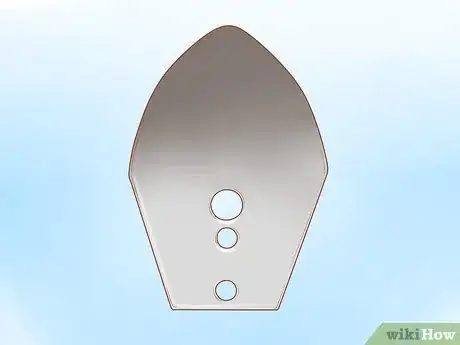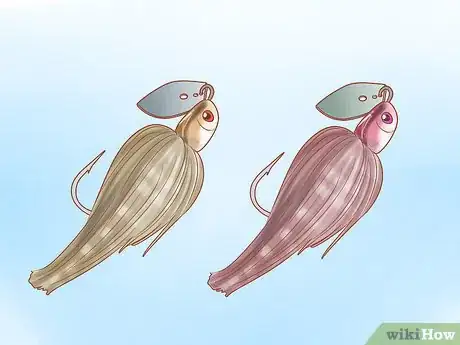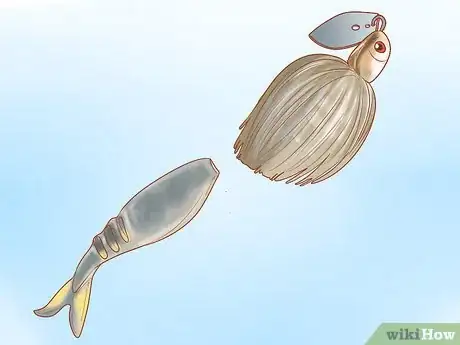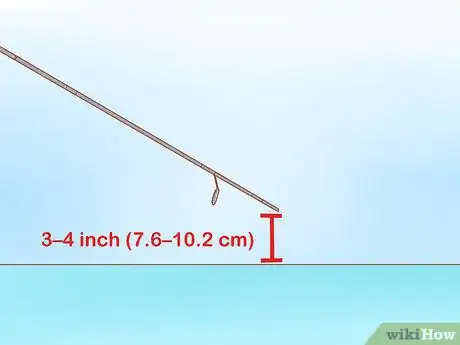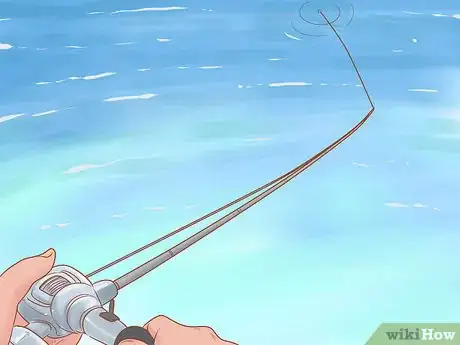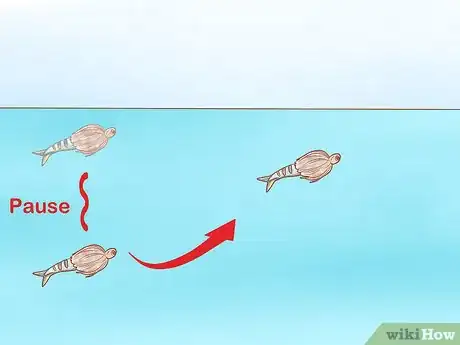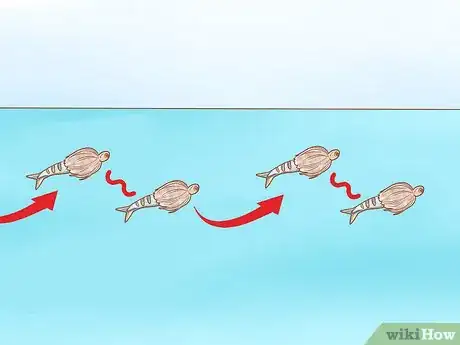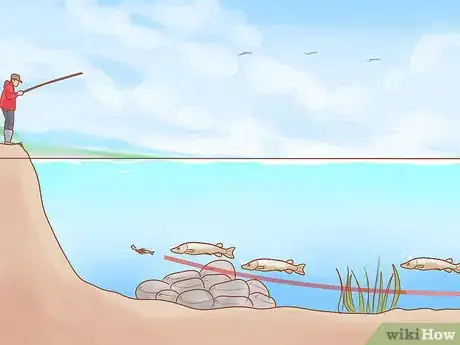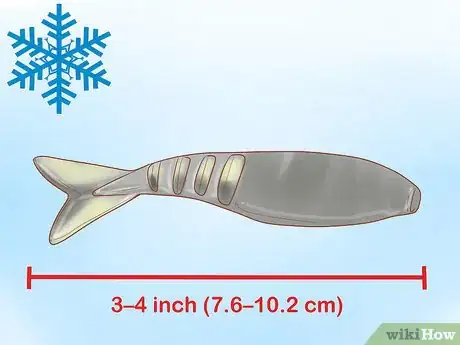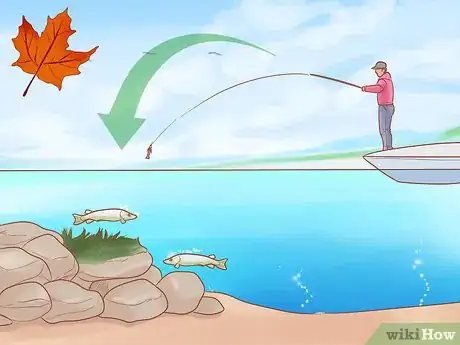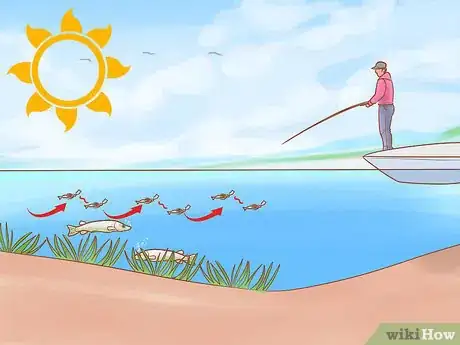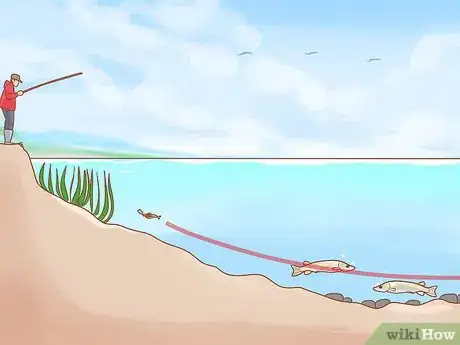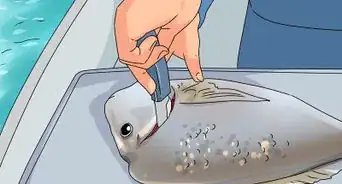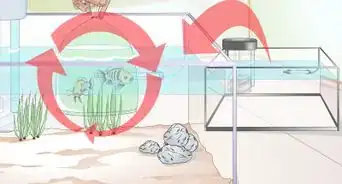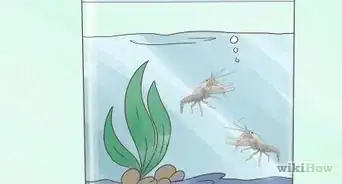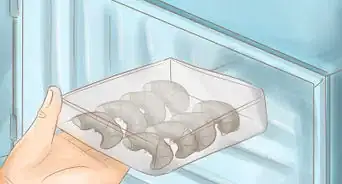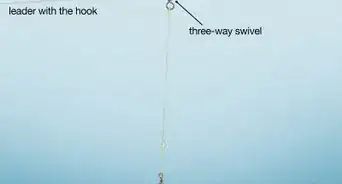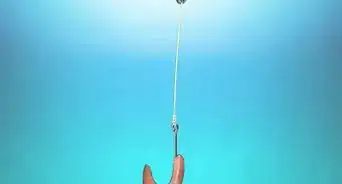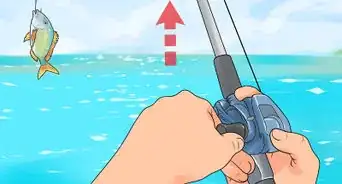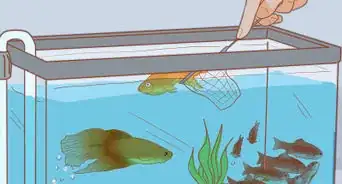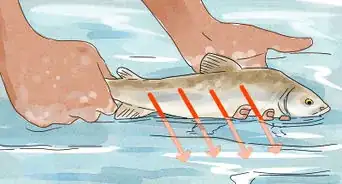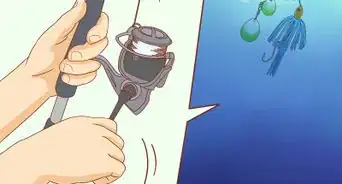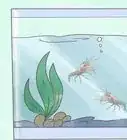This article was co-authored by wikiHow staff writer, Hunter Rising. Hunter Rising is a wikiHow Staff Writer based in Los Angeles. He has more than three years of experience writing for and working with wikiHow. Hunter holds a BFA in Entertainment Design from the University of Wisconsin - Stout and a Minor in English Writing.
This article has been viewed 16,829 times.
Learn more...
Chatterbaits are common lures used to catch bass since they are versatile and can be used during any season. The bait causes vibrations and clicking noises that attract fish in the water, no matter how murky it is. By choosing the right colors, varying how you reel in your line, and changing your tactics depending on the season, you can successfully use a chatterbait next time you fish!
Steps
Choosing the Right Bait
-
1Find a chatterbait with a stainless steel blade. The blade on the top of the chatterbait sends vibrations through the water as it's reeled in. Use a stainless steel blade shaped like a hexagon so it wobbles more in the water. Opt for a blade between 0.3–0.6 ounces (8.5–17.0 g) or else it could block the bait and the fish.[1]
- Chatterbait blades come in a variety of colors. Choose a dark-colored blade to resemble the shade of underwater plants.
-
2Pick a color that works best where you plan to fish. Blue and black chatterbaits work well in dark water since fish can see the silhouette better. In clearer waters, colors like chartreuse and shad will resemble bait fish that larger fish normally eat.[2]
- Keep different colors in your tackle box, since you may want to switch baits depending on where you fish.
Advertisement -
3Put a trailer on the line to imitate baitfish. Trailers can look like either smaller fish or crawfish. Find one that has ridges near the tail so it replicates a swimming action as it moves throughout the water. Put the hook from your chatterbait through the head of the trailer.[3]
- If you use a smaller trailer, the chatterbait may hide it. Use a pair of scissors to trim the skirt material shorter.[4]
Reeling in the Lure
-
1Keep your rod tip near the water as you reel your line in. After you cast, hold the tip of your rod 3–4 inches (7.6–10.2 cm) above the surface of the water. This helps keep the bait lower so it doesn't break the surface so more fish will be attracted to it.[5]
-
2Reel the chatterbait in at a constant speed. Don't reel in too fast or else the fish won't have time to strike the hook. Use a steady pace to keep the bait moving throughout the water. As you reel it in, the chatterbait will look like a small fish.[6]
- Vary the speed you reel your line it with each cast. Fish will react differently day to day.
-
3Pause while you reel in to make the blade move unpredictably. On some of your casts, stop reeling in and let the chatter bait sink for a few seconds. When you start bringing your lure in again, the blade will pulsate and move differently, making the fish go crazy for your lure.[7]
- Move your bait through the water near your boat to bring fish closer to you.
-
4Let the lure sink to the bottom and raise your rod to draw in fish. When you feel your lure hit the bottom, lift the tip of your rod and reel in your line for a few seconds. Stop again and let your chatterbait sink to the bottom again. Repeat this process until your line is back to you.[8]
- This technique is known as the “yo-yo approach.”
-
5Bump the bait into underwater objects to get fish to strike. Cast your line near rocky alcoves, fishing docks, or underwater vegetation and let your line sink to the bottom. Guide your line towards the structures so your bait bumps into them. After each bump, take a pause before you continue reeling it in.[9]
- Many fish will strike your bait when you pause after the bump.
- Switch up how you reel in your bait throughout the time you're fishing. Different fish will react to each type of retrieve you do.
Fishing in Different Seasons
-
1Use a 3–4 in (7.6–10.2 cm) trailer in the winter. The larger bait will give your target fish a more visible object to draw them in. Cast your line and let it sink between 6–9 feet (1.8–2.7 m) deep before reeling your line back in.
- Find schools of baitfish since larger fish will be close by.
-
2Cast near rocks and wood in the spring as the water warms up. Rocks and wood hold more heat underwater that fish seek out after a cold winter. Aim for shallow areas that drop off towards deeper water to attract deeper fish.
- Try fishing near the shoreline to where fish may have recently hatched.
-
3Reel your line in slowly through weeds in the summer. Larger fish will stay near the weeds since they are a good source of oxygen and are populated with prey fish. Cast towards weedy sections and use a constant slow speed as you reel it back in.
- If you notice the bait is vibrating less, check it for weeds when you've reeled it all the way in. They may have gotten stuck on the line, and fish will not strike a bait covered in vegetation.
-
4Jerk the bait in the water in the fall to lure the fish. Swim the lure on the bottom of the water and occasionally move the tip of your rod to the side. This causes the blade to create a natural vibration and noise to draw fish in.
References
- ↑ https://bearcaster.com/chatterbait-blades/
- ↑ https://www.bassfishermansguide.com/how-to-fish-a-chatterbait/
- ↑ https://www.bassfishermansguide.com/how-to-fish-a-chatterbait/
- ↑ https://youtu.be/tej0NsHeT5U?t=5m42s
- ↑ https://youtu.be/0sP27ZE6lKo?t=51s
- ↑ https://youtu.be/0sP27ZE6lKo?t=51s
- ↑ https://www.bassfishermansguide.com/how-to-fish-a-chatterbait/
- ↑ https://www.bassfishermansguide.com/how-to-fish-a-chatterbait/
- ↑ https://www.bassfishermansguide.com/how-to-fish-a-chatterbait/
About This Article
To fish chatterbait, consider putting a trailer on your line, which will imitate the swimming action of baitfish and increase your chances of getting a bite. Once you cast your line, hold the tip of your rod 3-4 inches above the surface of the water to keep the bait lower and attract more fish. When you reel in your line, use a steady pace to keep the bait moving, which will resemble a fish. However, try to switch up how you reel in your bait every time, since different fish will react to each type of retrieve. For example, try alternating between the start and stop method and the yo-yo technique, where you let your lure hit the bottom and lift it up again while reeling in your line. For more tips, including how to adjust your fishing techniques for the season, read on!
